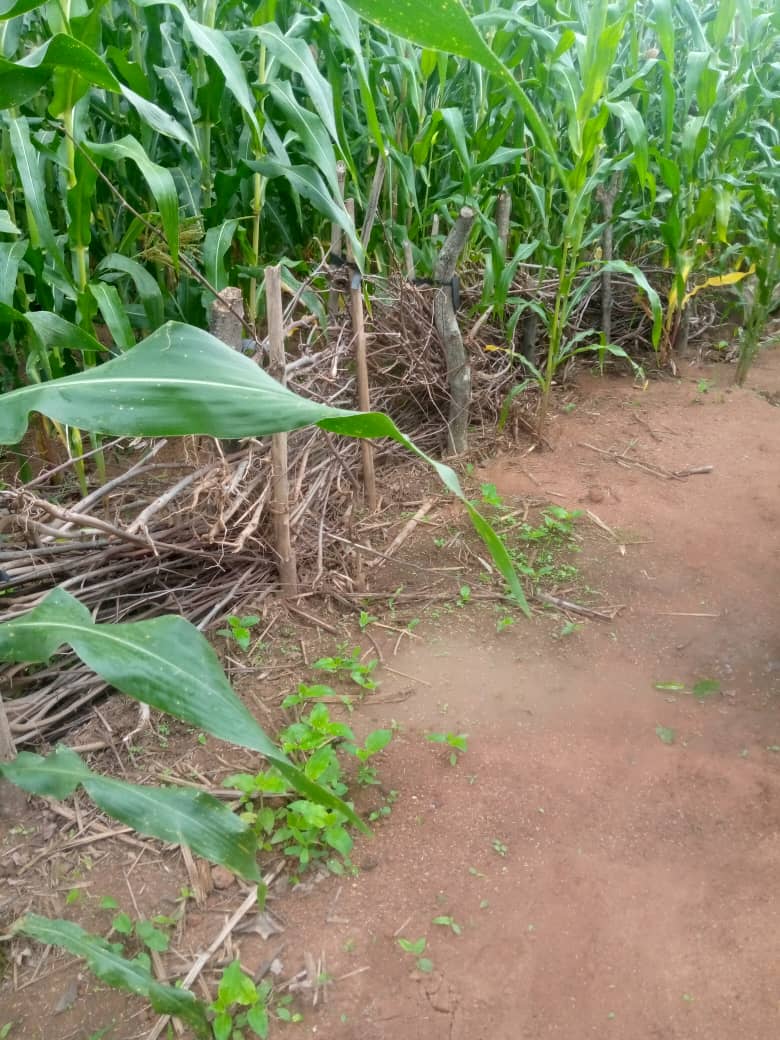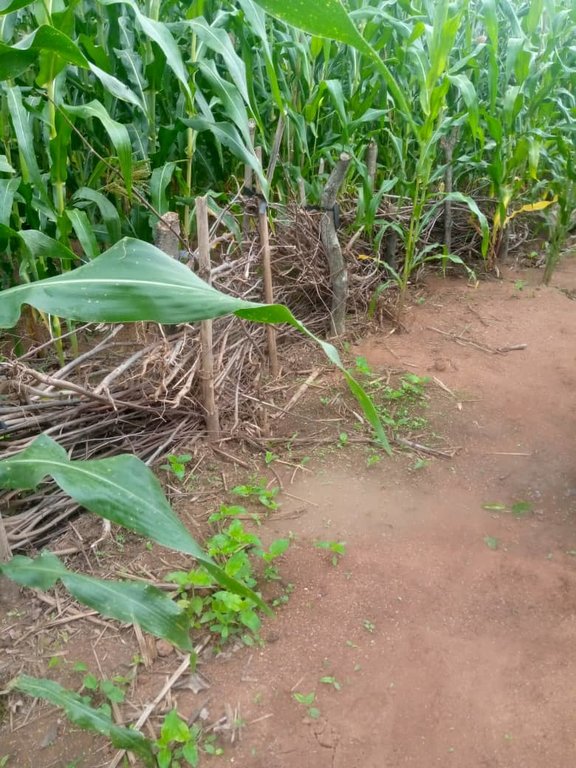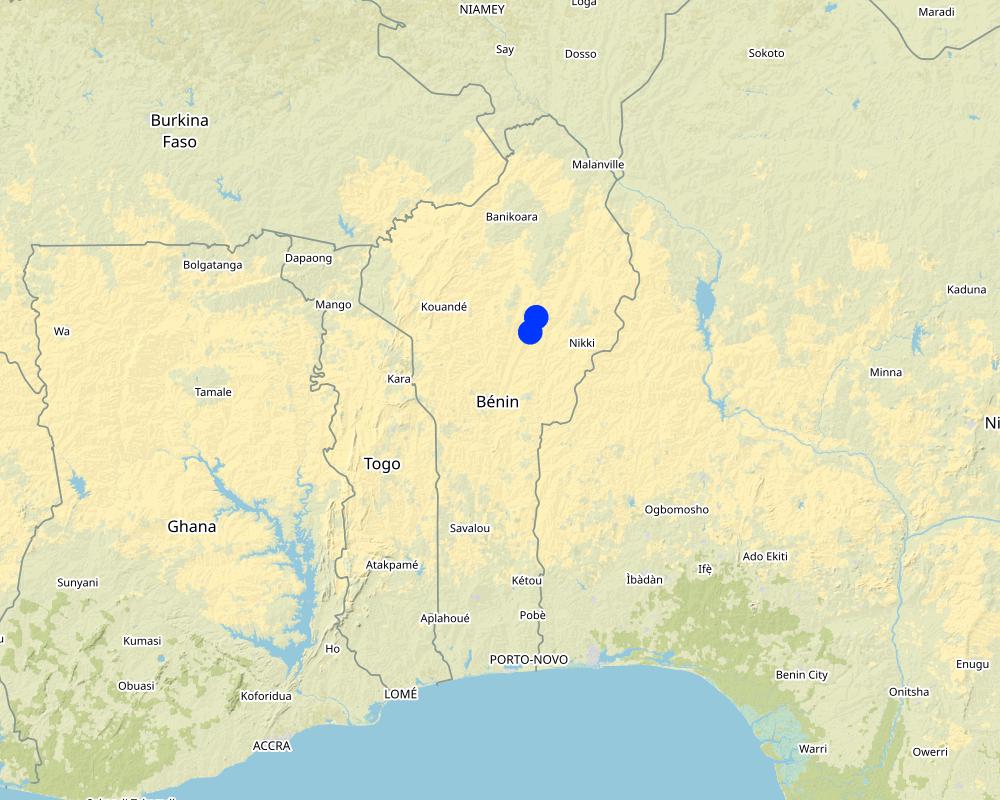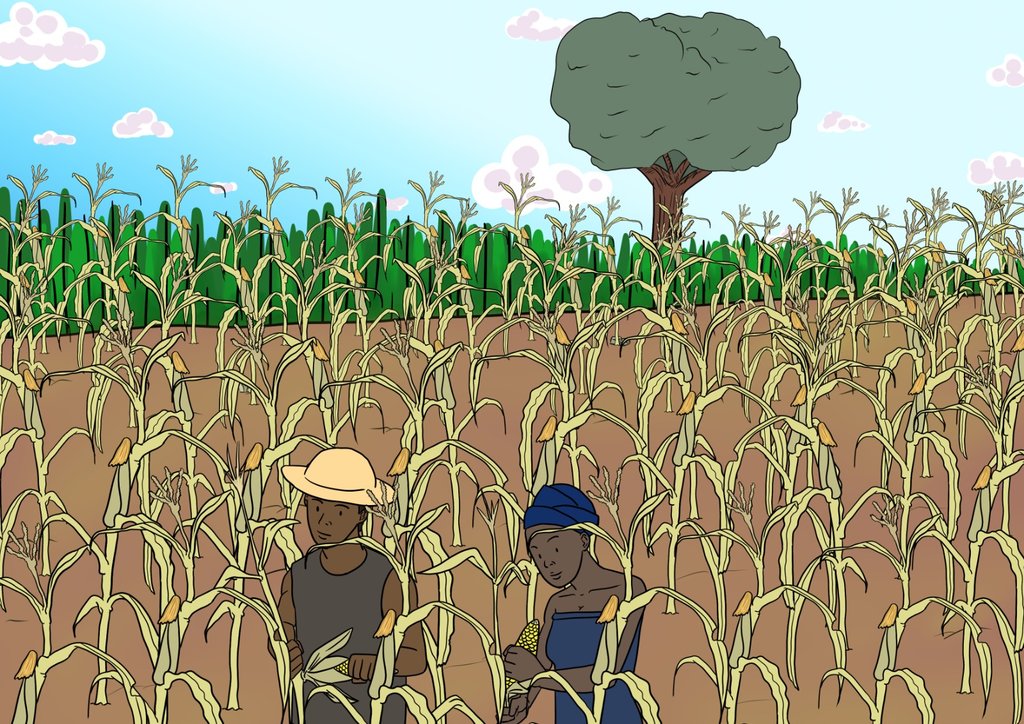Variétés à cycle court (maïs) [Benin]
- Creation:
- Update:
- Compiler: Gatien AGBOKOUN CHRISTOPHE
- Editors: Siagbé Golli, Abdoul Karim MIEN, DOSSOU-YOVO bernardin, Bona Ibouratou DAFIA, Oscar Assa KINDEMIN
- Reviewers: Sally Bunning, Rima Mekdaschi Studer
Carder gbérénou
technologies_6686 - Benin
View sections
Expand all Collapse all1. General information
1.2 Contact details of resource persons and institutions involved in the assessment and documentation of the Technology
Key resource person(s)
SLM specialist:
TAOUFIK Alassane
CAPID ONG
Benin
SLM specialist:
ABDOUL Kahar Mama
CAPID ONG
Benin
land user:
ZAKARI Mossa
CAPID ONG
Benin
land user:
ALASSANE Fouseni
CAPID ONG
Benin
Name of project which facilitated the documentation/ evaluation of the Technology (if relevant)
Soil protection and rehabilitation for food security (ProSo(i)l)Name of the institution(s) which facilitated the documentation/ evaluation of the Technology (if relevant)
Deutsche Gesellschaft für Internationale Zusammenarbeit - Bénin (GIZ Bénin) - Benin1.3 Conditions regarding the use of data documented through WOCAT
The compiler and key resource person(s) accept the conditions regarding the use of data documented through WOCAT:
Yes
1.4 Declaration on sustainability of the described Technology
Is the Technology described here problematic with regard to land degradation, so that it cannot be declared a sustainable land management technology?
No
2. Description of the SLM Technology
2.1 Short description of the Technology
Definition of the Technology:
Les variétés à cycle court sont les cultures dont la durée de maturité des produits n’excède plus de trois mois. Ces variétés dont notamment le maïs sont utilisées pour faire face aux aléas climatiques, surtout dans les zones où on enregistre un cycle irrégulier des pluies.
2.2 Detailed description of the Technology
Description:
L'utilisation des variétés à court cycle est une des mesures d'adaptation aux changements climatiques. Cette technologie est appliquée dans un environnement naturel.
Les quantités de semences nécessaires pour un hectare sont de 20kg à l'hectare. Il est semé à 40 cm sur les lignes et à 80 cm entre les lignes et à une profondeur de 3 à 5 cm à raison de 2 graines de maïs par poquet.
Les variétés à cycle court sont utilisées pour faire face aux aléas climatiques, surtout dans les zones où on enregistre un cycle irrégulier des pluies.
La mise en place et l’entretien passe par une succession d’opérations que sont la préparation de sol, l’achat des semences, le labour, le semis du maïs deux à 4 semaines avant le semis du pois d’angole. Ensuite suivent les opérations de sarclage et de sarclobuttage (au besoin).
Les variétés à cycle court permettent d’obtenir des produits agricoles autour de 45 jours voire jusqu’à 80 -90 jours au plus. Au Bénin on peut donner un répertoire de quelques variétés à cycle court dont la liste n’est pas exhaustive pour le maïs. Il s'agit de BEMA14 J-07, BEMA14 J-08, BEMA14 J-15, BEMA00 J-20, BEMA14 B-09, BEMA14 B-10, EV DT 97 STR W, DMR ESR W BENIN, BEMA 94 B15, 2000 SYN EE W etc.
Les producteurs apprécient les variétés précoces à cause de leur aptitude de raccourcissement sur la maturité des produits, vu le contexte auquel nous vivons actuellement (changements climatiques). Pour les femmes particulièrement, les maïs à cycle court constituent de véritables sources de revenus. Dans ces périodes, elles le vendent frais, cuit ou grillé. Toutefois, il urge de noter que la majorité de ces variétés ont des exigences en termes d’entretien, d’intrants à apporter et des coûts de réalisation qu’elles engendrent.
2.3 Photos of the Technology
2.5 Country/ region/ locations where the Technology has been applied and which are covered by this assessment
Country:
Benin
Region/ State/ Province:
Borgou
Further specification of location:
Bembéréké
Specify the spread of the Technology:
- evenly spread over an area
Is/are the technology site(s) located in a permanently protected area?
No
Map
×2.6 Date of implementation
If precise year is not known, indicate approximate date:
- 10-50 years ago
2.7 Introduction of the Technology
Specify how the Technology was introduced:
- through projects/ external interventions
Comments (type of project, etc.):
Les variétés à cycle court dont le maïs ont été introduites par l'Etat à travers ses structures déconcentrées.
3. Classification of the SLM Technology
3.1 Main purpose(s) of the Technology
- improve production
- reduce risk of disasters
- adapt to climate change/ extremes and its impacts
- create beneficial economic impact
3.2 Current land use type(s) where the Technology is applied
Land use mixed within the same land unit:
No

Cropland
- Annual cropping
Annual cropping - Specify crops:
- cereals - maize
Number of growing seasons per year:
- 2
Specify:
En utilisant les variétés à cycle court, les producteurs après avoir récolté le maïs mettent ou le soja ou le niébé
Is crop rotation practiced?
Yes
If yes, specify:
Soja ou Niébé
3.3 Has land use changed due to the implementation of the Technology?
Has land use changed due to the implementation of the Technology?
- Yes (Please fill out the questions below with regard to the land use before implementation of the Technology)
Land use mixed within the same land unit:
No

Cropland
- Annual cropping
Annual cropping - Specify crops:
- cereals - maize
Is crop rotation practiced?
Yes
If yes, specify:
La rotation implique le coton et s'agit d'une rotation saisonnière. Toutefois, il y a une rotation entre le maïs, le soja et le niébé au cours de la même saison
3.4 Water supply
Water supply for the land on which the Technology is applied:
- rainfed
3.5 SLM group to which the Technology belongs
- Mesure d'adaptation aux changements climatiques
3.6 SLM measures comprising the Technology

management measures
- M1: Change of land use type
- M4: Major change in timing of activities
3.7 Main types of land degradation addressed by the Technology

water degradation
- Ha: aridification
3.8 Prevention, reduction, or restoration of land degradation
Specify the goal of the Technology with regard to land degradation:
- not applicable
Comments:
S'adapter aux changements climatiques
4. Technical specifications, implementation activities, inputs, and costs
4.1 Technical drawing of the Technology
Technical specifications (related to technical drawing):
Avant de réaliser le semis, il faut une pluviométrie d'au moins 20mm suffisante pour permettre une bonne germination des graines. Le semis est soit manuel ou mécanique. la date optimale de semis se situe entre le 15 mai et le 15 juin après une pluie suffisante pour permettre une bonne germination des graines. 20kg de semences sont nécessaires pour le semis à l'hectare.
Pour ce qui est de la densité de semis, pour ce qui est des variétés extra précoces (70-84 jours), il faut 83000 plants à l'hectare (0,80m x 0,30m ou 0,75m x 0,32m) et de 65750 pour les variétés précoces (95-94 jours) soit 0,80m x 0,38m ou 0,75m x 0,40.
4.2 General information regarding the calculation of inputs and costs
Specify how costs and inputs were calculated:
- per Technology area
Indicate size and area unit:
1ha
other/ national currency (specify):
Francs CFA
4.3 Establishment activities
| Activity | Timing (season) | |
|---|---|---|
| 1. | Préparation du sol (Défrichage) | Mars - Avril |
| 2. | Labour | Avril - Mai |
| 3. | Semis | Mai - Juin |
| 4. | Récolte | Juillet |
4.4 Costs and inputs needed for establishment
| Specify input | Unit | Quantity | Costs per Unit | Total costs per input | % of costs borne by land users | |
|---|---|---|---|---|---|---|
| Labour | Préparation du sol (Défrichage) | ha | 1.0 | 17000.0 | 17000.0 | 100.0 |
| Labour | Labour | ha | 1.0 | 30000.0 | 30000.0 | 100.0 |
| Labour | Semis | ha | 1.0 | 15000.0 | 15000.0 | 100.0 |
| Plant material | Semences | ha | 20.0 | 300.0 | 6000.0 | 100.0 |
| Total costs for establishment of the Technology | 68000.0 | |||||
| Total costs for establishment of the Technology in USD | 68000.0 | |||||
4.5 Maintenance/ recurrent activities
| Activity | Timing/ frequency | |
|---|---|---|
| 1. | Sarclage | Juin |
| 2. | Sarclobuttage | Juin |
| 3. | Epandage d'engrais | Juin |
4.6 Costs and inputs needed for maintenance/ recurrent activities (per year)
| Specify input | Unit | Quantity | Costs per Unit | Total costs per input | % of costs borne by land users | |
|---|---|---|---|---|---|---|
| Labour | Sarclage | ha | 1.0 | 15000.0 | 15000.0 | 100.0 |
| Labour | Sarclobuttage | ha | 1.0 | 200000.0 | 200000.0 | 100.0 |
| Labour | Epandage d'engrais | sac | 4.0 | 2500.0 | 10000.0 | 100.0 |
| Fertilizers and biocides | NPK | sac | 3.0 | 16000.0 | 48000.0 | 100.0 |
| Fertilizers and biocides | Urée | sac | 1.0 | 16000.0 | 16000.0 | 100.0 |
| Total costs for maintenance of the Technology | 289000.0 | |||||
| Total costs for maintenance of the Technology in USD | 289000.0 | |||||
4.7 Most important factors affecting the costs
Describe the most determinate factors affecting the costs:
La main d'oeuvre pour le labour et le sarclage
5. Natural and human environment
5.1 Climate
Annual rainfall
- < 250 mm
- 251-500 mm
- 501-750 mm
- 751-1,000 mm
- 1,001-1,500 mm
- 1,501-2,000 mm
- 2,001-3,000 mm
- 3,001-4,000 mm
- > 4,000 mm
Specify average annual rainfall (if known), in mm:
1023.00
Specifications/ comments on rainfall:
De type soudano-guinéen, le climat de la commune de Bembèrèkè se caractérise par une grande saison de pluies (avril à octobre) et une grande saison sèche (novembre à mars).
Agro-climatic zone
- sub-humid
5.2 Topography
Slopes on average:
- flat (0-2%)
- gentle (3-5%)
- moderate (6-10%)
- rolling (11-15%)
- hilly (16-30%)
- steep (31-60%)
- very steep (>60%)
Landforms:
- plateau/plains
- ridges
- mountain slopes
- hill slopes
- footslopes
- valley floors
Altitudinal zone:
- 0-100 m a.s.l.
- 101-500 m a.s.l.
- 501-1,000 m a.s.l.
- 1,001-1,500 m a.s.l.
- 1,501-2,000 m a.s.l.
- 2,001-2,500 m a.s.l.
- 2,501-3,000 m a.s.l.
- 3,001-4,000 m a.s.l.
- > 4,000 m a.s.l.
Indicate if the Technology is specifically applied in:
- not relevant
5.3 Soils
Soil depth on average:
- very shallow (0-20 cm)
- shallow (21-50 cm)
- moderately deep (51-80 cm)
- deep (81-120 cm)
- very deep (> 120 cm)
Soil texture (topsoil):
- coarse/ light (sandy)
- medium (loamy, silty)
Soil texture (> 20 cm below surface):
- coarse/ light (sandy)
- medium (loamy, silty)
Topsoil organic matter:
- low (<1%)
5.4 Water availability and quality
Ground water table:
5-50 m
Availability of surface water:
medium
Water quality (untreated):
good drinking water
Water quality refers to:
ground water
Is water salinity a problem?
No
Is flooding of the area occurring?
No
5.5 Biodiversity
Species diversity:
- medium
Habitat diversity:
- medium
5.6 Characteristics of land users applying the Technology
Sedentary or nomadic:
- Sedentary
Market orientation of production system:
- commercial/ market
Off-farm income:
- less than 10% of all income
Relative level of wealth:
- poor
- average
Individuals or groups:
- groups/ community
Level of mechanization:
- animal traction
- mechanized/ motorized
Gender:
- women
- men
Age of land users:
- youth
- middle-aged
5.7 Average area of land used by land users applying the Technology
- < 0.5 ha
- 0.5-1 ha
- 1-2 ha
- 2-5 ha
- 5-15 ha
- 15-50 ha
- 50-100 ha
- 100-500 ha
- 500-1,000 ha
- 1,000-10,000 ha
- > 10,000 ha
Is this considered small-, medium- or large-scale (referring to local context)?
- small-scale
- medium-scale
5.8 Land ownership, land use rights, and water use rights
Land ownership:
- communal/ village
Land use rights:
- communal (organized)
Water use rights:
- communal (organized)
Are land use rights based on a traditional legal system?
Yes
Specify:
Les terres appartiennent aux collectivités familiales
5.9 Access to services and infrastructure
health:
- poor
- moderate
- good
education:
- poor
- moderate
- good
technical assistance:
- poor
- moderate
- good
employment (e.g. off-farm):
- poor
- moderate
- good
markets:
- poor
- moderate
- good
energy:
- poor
- moderate
- good
roads and transport:
- poor
- moderate
- good
drinking water and sanitation:
- poor
- moderate
- good
financial services:
- poor
- moderate
- good
6. Impacts and concluding statements
6.1 On-site impacts the Technology has shown
Socio-economic impacts
Production
crop production
risk of production failure
product diversity
Income and costs
expenses on agricultural inputs
farm income
Comments/ specify:
Grâce aux varitétés à cycle court, le producteur a la possibilité de faire plusieurs récoltes
6.3 Exposure and sensitivity of the Technology to gradual climate change and climate-related extremes/ disasters (as perceived by land users)
Gradual climate change
Gradual climate change
| Season | increase or decrease | How does the Technology cope with it? | |
|---|---|---|---|
| annual temperature | increase | moderately | |
| seasonal temperature | wet/ rainy season | decrease | moderately |
| annual rainfall | decrease | moderately | |
| seasonal rainfall | wet/ rainy season | decrease | well |
6.4 Cost-benefit analysis
How do the benefits compare with the establishment costs (from land users’ perspective)?
Short-term returns:
very positive
Long-term returns:
positive
How do the benefits compare with the maintenance/ recurrent costs (from land users' perspective)?
Short-term returns:
very positive
Long-term returns:
positive
6.5 Adoption of the Technology
- > 50%
Of all those who have adopted the Technology, how many did so spontaneously, i.e. without receiving any material incentives/ payments?
- 11-50%
Comments:
Il s'agit ici des producteurs qui sont allés cherchés les semences avant même que ProSOL ne mette à leur disposition les premières semences.
6.6 Adaptation
Has the Technology been modified recently to adapt to changing conditions?
No
6.7 Strengths/ advantages/ opportunities of the Technology
| Strengths/ advantages/ opportunities in the land user’s view |
|---|
| Augmentation des rendements de cultures |
| Rapidité de la maturité des produits agricoles |
| . Possibilité de succession culturale sur la même parcelle |
| Strengths/ advantages/ opportunities in the compiler’s or other key resource person’s view |
|---|
| Capacité d’adaptation aux aléas climatiques |
| Occasionne la diversification de revenus agricoles |
6.8 Weaknesses/ disadvantages/ risks of the Technology and ways of overcoming them
| Weaknesses/ disadvantages/ risks in the land user’s view | How can they be overcome? |
|---|---|
| Coût élevé des semences | Promouvoir davantage l'émergence de semenciers |
| Exigence d’une main d’œuvre importante | Combiner les mains d’ouvres (salariée et familiale) pour une synergie d’actions |
| Difficultés de conservation jusqu’à un temps souhaité pour la commercialisation.. | Vente aux femmes qui le vendent bouillis ou grillés |
| Weaknesses/ disadvantages/ risks in the compiler’s or other key resource person’s view | How can they be overcome? |
|---|---|
| Exigence d’intrants | Utilisation de l’engrais bio et résidus de récolte pour réduire les coûts de production |
7. References and links
7.1 Methods/ sources of information
- field visits, field surveys
2
- interviews with land users
2
- interviews with SLM specialists/ experts
2
- compilation from reports and other existing documentation
4
When were the data compiled (in the field)?
08/02/2023
7.2 References to available publications
Title, author, year, ISBN:
Deutsche Gesellschaft für Internationale Zusammenarbeit (GIZ) GmbH, 2018, Compendium de fiches techniques du formateur,
Title, author, year, ISBN:
ACMA 2, 2019, Fiche Technique : Itinéraire technique du maïs
Available from where? Costs?
https://ifdc.org/wp-content/uploads/2019/07/FICHE-TECHNIQUE-1-ITINERAIRE-TECHNIQUE-DU-MAI%CC%88S-MAIZE-TECHNICAL-ITINERARY.pdf
Title, author, year, ISBN:
Deutsche Gesellschaft für Internationale Zusammenarbeit (GIZ) GmbH, 2018, Mesures de Gestion Durable des Terres (GDT) et d’Adaptation au Changement Climatique (ACC) : Boîte à images pour l’animation des séances de formation avec les agriculteurs
7.3 Links to relevant online information
Title/ description:
FICHE TECHNIQUE SYNTHETIQUE POUR LA PRODUCTION DU MAÏS JAUNE (Zea mays L.)
URL:
https://gbios-uac.org/wp-content/uploads/2019/03/FICHE-TECHNIQUE-SYNTHETIQUE-POUR-LA-PRODUCTION-DU-MA%C3%8FS-JAUNE-Zea-mays-L..pdf
Links and modules
Expand all Collapse allLinks
No links
Modules
No modules





